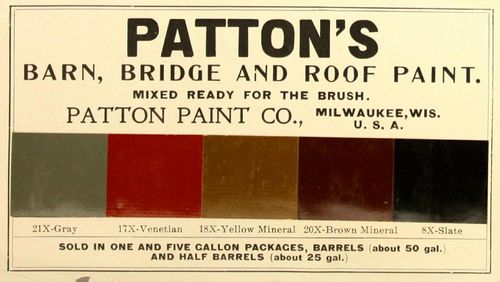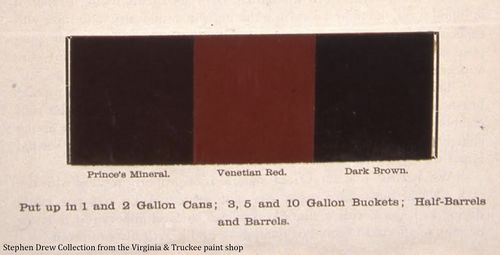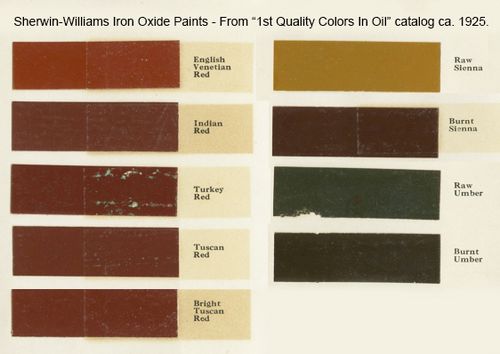Oxide and Metallic Paints
In railroad terms, "Oxide," "Metallic," and "Mineral" are generally interchangeable, referring to deep brown paints mixed from iron oxide pigments. These are what are commonly referred to as "freight car brown" or "boxcar red." Outside of the railroad industry, iron oxide pigments are called "earth colors" and include the ochres, siennas and umbers.
A number of factors contribute to the color of an iron oxide paint: the chemical composition of the oxide, the quarry where it was mined, how finely the pigment is ground, whether the pigment is baked ("burnt" or dehydrated), and any special additives included by the manufacturer. Most "mineral" paints such as "Iron-Clad" and "Rawlins Red" brands are produced from hematite (Fe2O3), an iron ore that varies from reddish-brown to black in the wild and produces a pigment ranging from bright earthy red to dark brown once processed, although mineral paints manufactured from limonite (FeO(OH)·nH2O) tend towards the yellow-orange spectrum.
Flexite Metal Preservative Paint
Flexite was a product line of the Standard Paint Company of New York. It was available in a number of colors including mineral/metallic.
1904
The Pittsburgh & Lake Erie performed a thorough experiment comparing all available paint products and methods on steel cars and reported the results to the Master Car and Locomotive Association Conference. Hopper coal cars 10695 and 10686 are painted with Flexite New Standard Steel Car Painting System, a product originally marketed for painting iron buildings. 10695 was painted red iron oxide and 10686 was painted black. At the time of the presentation the results of this paint product were undetermined.
1911
Flexite is listed in the 1911 Sweet's Catalogue of Building Construction:
"'Flexite' Metal Preservative Paints (black and colors) are for all metal surfaces exposed to the weather, dampness, salt air or corrosive gases, including structural iron and steel, bridges, siding, roofs, fences, railing, ornamental work. Made from the most carefully selected inert pigments with a vehicle containing absolutely pure refined linseed oil, in combination with one of the most refractory materials known to science, they present exceptional qualities for resisting severe conditions. They may be used with or without 'Flexite Primer.'
"'Flexite' Primer is recommended for a Shop coat in connection with 'Flexite' Paints. It consists of a transparent fibrous pigment, ground very fine in pure linseed oil. It dries to a hard transparent coat, which will permit inspection of the underlying metal. The fibrous nature of the pigment adds to the tenacity of the coating and its low specific gravity permits it to remain in perfect suspension in linseed oil."
Sweet's Architectural Catalog File, 1911 p68.
Iron Clad Paint Company
Located in Cleveland Ohio, this company manufactured an iron-based paint based on patents developed by William Green using iron ore from the Lake Superior region.
1866
William Greene is issued patent No. 53,140 on 13 march 1866 for "Improved Roofiing-Cement, Paint & c."
"I, William Green, of Cleveland, in the county of Onyahoga, and State of Ohio, have invented a new and useful improvement in Paint, applicable also as a roofing cement and other purposes; and I do hereby declare that the following is a full and complete description of the ingredients used therein, and of the manner of compounding and using the same.
"I first take iron-ore of the kind found in the vicinity of Lake Superior, which is a silicate of the oxide of iron, and reduce or crush it to a finely-divided state by any convenient means.
"I next mix this reduced ore, which, if desired, may be sifted, with flax-seed, or other oil, and if desirable, add, in suitable proportions, any suitable ingredient or compound known among painters as a drier, and which may be composed of gum-shellac, linseed-oil, and litharge, or oxide of lead.
"The mass may then be thinned, if desired, by, for instance, mixing with it spirits of turpentine or naphtha, to any required consistency, which will vary according to the purpose to which the mass is intended to be applied.
"If designed to be used as paint, to be laid on with the brush, said mass will necessarily require to be thinner than when used as a cement, or mastic, to be spread with the trowel, which may be done to any desired thickness.
"As a paint, after having been laid, it soon becomes hard and dry.
"Applied as a roofing-cement, it may be laid on boards, shingles, canvass, or other suitable material, the surface upon which it is laid preferably being smooth, even, and firm, said cement soon becoming hard and firm.
"Such cement may also be used as a finish to the fronts of brick buildings, in which case it is desirable that the bricks should first be prepared with a coating of oil, to prevent the absorption of the oil in the cement.
"What I claim as my invention, and desire to secure by Letters Patent, is - A paint or cement, composed of the ingredients herein set forth, prepared and compounded in the manner specified."
"Improved Roofing-Cement, Paint, & C.," United States Patent Office: 9 February 1869.
1869
Patent No. 53,140 is granted reissue No. 3,288 on 9 February 1869.
1872
The Toledo, Wabash & Western Railway announces that it uses Iron Clad metallic paint.
The National Car Builder, September 1872, pg. 18
1874
An advertisement in the October issue of The National Car Builder lists the following railroads as customers:
- Lake Shore & Michigan Southern Railway
- Detroit & Milwaukee Railway
- Ohio & Mississippi Railway
- Kansas Pacific Railroad
- Toledo, Wabash & Western Railway
- Indianapolis & St. Louis Railroad
- Cleveland, Columbus, Cincinnati & Indianapolis Railway
- Louisville, Cincinnati & Lexington Railroad
- Lake Shore & Tuscarawas Valley Railroad
"Gentlemen: Your 'Metallic Paints' known as 'Iron Clad Paints' have, in the past six years, been extensively used and thoroughly tested by this Company, as to their covering capacity, durability, and resistance to atmospheric changes - latter 'paint destroyer' - the most difficult to overcome in outside paints. We can emphatically accord them the highest position over any paint heretofore produced, for Cars, Roofs, Stations, Bridges, etc. The monthly increase of our orders is the best evidence that the paint is constantly growing in favor with our mechanics. Very respectfully yours, A.C. Armstrong, Gen'l Purchasing Agent L.S.&M.S.R.R."
1879
The property inventory of the Denver & Rio Grande, prepared during the Royal Gorge War settlement with the Atchison, Topeka & Santa Fe, lists Iron Clad Mineral Paint in the Denver paint shop stock.
Inventory of Tools, Material, Equipment & Other Property of Denver & Rio Grande Railway Trasnferred to Receiver, Aug. 14, 1879 by Atchison, Topeka & Santa Fe Railroad. Original ledger number 66 from the collection of Jason Sanford.
1904
The Pittsburgh & Lake Erie performed a thorough experiment comparing all available paint products and methods on steel cars and reported the results to the Master Car and Locomotive Association Conference. Hopper coal cars 10686 and 10671 are painted two coats ready mixed "Iron-Clad" paint on 4 August 1904. After one year, car 10671 was identified and the paint reported as being "very hard and dry."
Kohler-McLister
Kohler-McLister offered KM-91 "Box Car Red" to the railroad market.
Patton's Sun Proof Paint
A product of the Patton Paint Company of Milwaukee. Sun-Proof Paint was a pre-mixed liquid paint and was available in in a range of colors; iron oxide was only one pigment within the line, sold as No.20X "Brown Mineral".
Patton Paint Company was incorporated in January 1892 by James E. Patton. That fall his factory burned to the ground in a major business district fire so the company relocated to the center of Milwaukee to allow rail access.
"Where and How Pattons Sun Proof Paints are Made," Wetzel Bros. Printing Co., Milwaukee
1904
The Pittsburgh & Lake Erie performed a thorough experiment comparing all available paint products and methods on steel cars and reported the results to the Master Car and Locomotive Association Conference. Hopper coal car 13686 is painted two coats "Sun-Proof" iron oxide ready mixed paint. The railroad reported that the pigment was finely ground but the results of the experiment were not available in time for the convention.
1918
"Patton's Sun-Proof Liquid Paint is made from white lead, oxide of zinc, silica and coloring matter, ground in strictly pure linseed oil, and specially prepared drier. Sun-Proof Paint contains the maximum quantity of linseed oil consistent with good paint, and the quantity of linseed oil is in the proper relative proportion to the pigment to produce a tough, durable, wear resisting paint film - a paint that can be spread uniformly and a paint that is suitable for all general purposes."
Sweet's Architectural Catalogue Vol. 13, 1918 p1333.
Pennsylvania Railroad
1890
Passenger car paint specification adopted as Tuscan red paint pigment: 80% sesquioxide of iron (Fe2O3, red iron oxide), 15% “organic coloring matter,” and 5% carbonate of lime (calcium carbonate; to facilitate drying).
The Railroad and Engineering Journal, May 1891, p251.
1891
Third draft of official paint specifications gives the freight car color recipe as paint pigment 50% sesquioxide of iron (Fe2O3 hematite), 45% hydrated gypsum (as a binder), and 5% carbonate of lime (calcium carbonate; to facilitate drying).
The Railroad and Engineering Journal, May 1891, p224.
The ratio of gypsum to iron oxide in Pennsylvania's pigment mix resulted in a lighter red than is commonly associated with freight car colors, which faded to a deep orange.
Prince's Mineral/Prince's Metallic
See Prince Bros. Mineral Brown
Prince's Metallic, also branded as Prince's Mineral Paint, was produced from iron ore mined along the Lehigh River in Carbon County, Pennsylvania.
Railroads documented to have used Prince's Mineral Paint:
- Chicago & Eastern Illinois Railroad
- Fitchburg Railroad
- New York, Lake Erie & Western
- South Carolina Railway
- Union Pacific
Rawlins Metallic Paint
Advertised as being "90 per cent iron."
1874
Advertisements for Rawlins Metallic Paint first appear in the National Car Builder.
"Owing to its extreme fineness, every particle is utilized. No sediment settles to the bottom, and when applied, it produces a smooth, glossy surface. With less oil to the pound, this paint will go over twice the space of other so-called "Mineral" paint, and produces a more intense color. It is entirely free from dirt, slate, or any impurities, being manufactured out of the best Red Hematite Iron Ore, and pulverized finer than any paint that has heretofore been manufactured by a process peculiar to this company. This paint is not affected by water or extremes of cold and heat, and is peculiarly adapted for tin roofs. It will also stand hard usage, and for railroad cars or wagons can not be excelled. It has been used by the Union Pacific Railroad Company, and by whom it is pronounced superior to any quality they have ever used. Address Rawlins' Metallic Paint Company, Rawlins, Wyoming."
1876
Advertisements for Rawlins Metallic Paint first appear in the April 15th issue of the American Railroad Journal.
"The Cheapest, Best, Most Durable, Most Fire, Water and Weather Proof paint made. Used by the Pacific Mail Steamship Co., and the Union Pacific R.R. Co. Address all Orders: Rawlins Metalic Paint Co., Rawlins, Wyoming Territory. C.F. Goodman, Omaha, Neb.; John Alston & Co., 179 and 181 Randolph St., Chicago, Ill."
Sherwin-Williams
Sherwin-Williams provided a number of iron oxide colors.
Italian Sienna
"Italian Sienna comes from Sienna in Tuscany. The raw is a peculiar Yellow and when burned is a rich semi-transparent Red. Raw Sienna contains the same coloring pigment as Ochre, the principal difference between them lies in the very large percentage of of iron, as while Ochre contains approximately 20%, Raw Sienna frequently contains 75% and upwards. Burnt Sienna is obtained by roasting the Raw. The peculiar feature of Burnt Sienna is the extreme brilliancy which it gives to transmitted light. On account of its brilliancy, Burnt Sienna is largely used in connection with the manufacture of Stains and Lacquers."
Turkey Umber
"Turkey Umber is a native earth largely found in the island of Cyprus. Umber contains about 46% Oxide of Iron; the balance, as in other pigments, being earthy matter, except that Umber contains about 5% Oxide of Manganese. It is this ingredient which gives to Umber its brilliant color and its drying qualities."
Tuscan Red
"Tuscan Red is an earth color containing a large amount of iron oxide which has been dyed with Madder Lake, which is the fastest red known to chemists. This combination of iron oxide and brilliant red lake produces a beautiful rich color which is the most valuable and permanent of the earth pigments."
Indian and Venetian Red
"Indian and Venetian Reds are Iron Oxides obtained by burning suitable Ochres and especially in the Venetian by calcining Copperas with a suitable base, usually gypsum."
Yellow Ochre
"Yellow Ochre is a native earth and probably no other pigment used in painting is more widely distributed or found in such exhaustless quantities as this. Yet only a small quantity is suitable for the very highest grade of painting. The Yellow Ochre we use is imported from Southern France, that being the only source of supply for good Ochre, so far as we know."
"Sherwin-Williams 1st Quality Colors in Oil," Paint Catalog ca. 1925
Railroad known to have used Sherwin-Williams paint:




